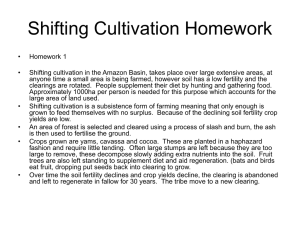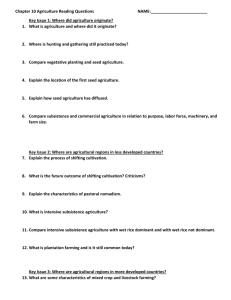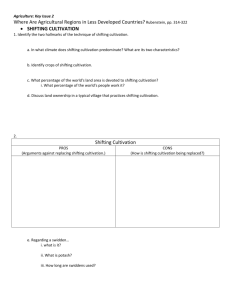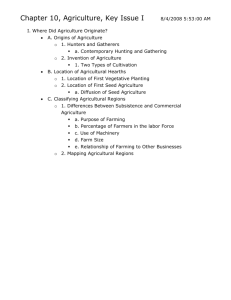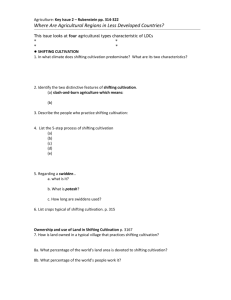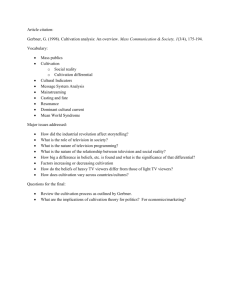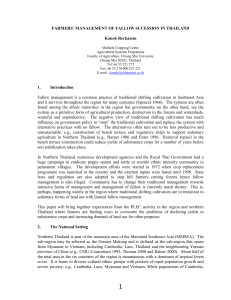Shifting Agriculture 1
advertisement
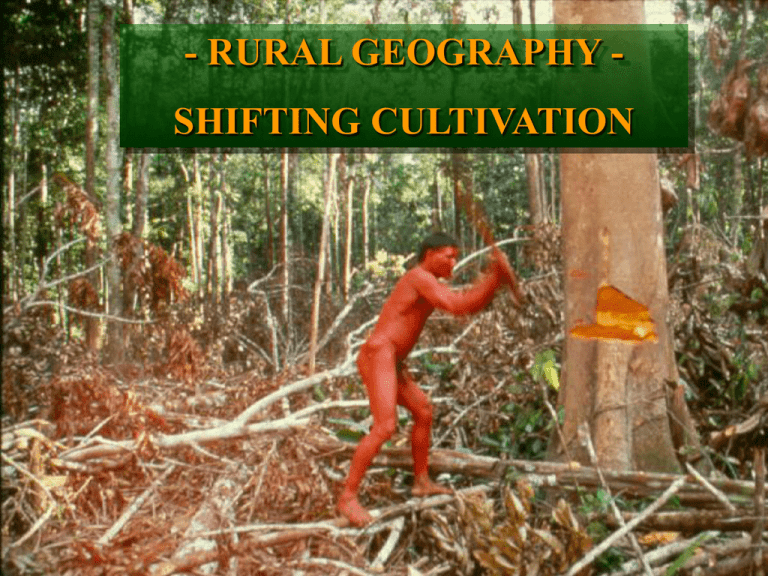
- RURAL GEOGRAPHY SHIFTING CULTIVATION Title Main learning outcomes: you should… • be able to describe the main features of this type of farming, including the crops grown, the level of technology used and the main activities throughout the year. • be able to describe and explain the settlement pattern and the population density. • be familiar with the changes occurring in areas of shifting cultivation and the impact of these changes on the people and the landscape. INTRODUCTION One of the most primitive form of farming found on the earth, Shifting Agriculture still supports over 300 million people. This type of farming has probably existed for over 10,000 years and was once very widespread – even found in stone-age Europe. Largely replaced by sedentary or fixed farming, it is now in danger of disappearing altogether. It is now found mainly in equatorial rainforest areas. Tropic of Cancer Amazon Basin Centra l Africa Indonesia and PNG. Equator Tropic of Capricorn Global Distribution of Shifting Cultivation Around the World… • Shifting cultivation is also known as:• Slash and Burn; or • Ladang (Malaysia) • Roca (Brazil); • Masole (Congo) • Milpa (Mexico) • This presentation looks at examples from the Amazon Basin and Papua New Guinea Types of Shifting Cultivation • Shifting Cultivation proper; • Permanent village, shifting cultivated areas; • Rotational bush fallowing. Shifting Cultivation proper… • In Shifting Cultivation in its purest form, clearings are made in the forest, used for two to five years to grow food, then abandoned and a new clearing created. This is repeated, with the village eventually returning to the original site after 25 years or more – or maybe never. • Such frequent moves are necessary because the soil quickly loses its fertility and crops will start to fail after only a few years. • Abandoned clearings will be reclaimed by the forest and gradually the soil fertility will recover. …Shifting village and cultivation …permanent village, shifting cultivation • This variation is probably more common, particularly in Africa. • In this system, the village remains in one place and the farmed clearing is changed every few years. The old clearing is left “fallow” or rested. • This system is found where the population is permanent, the total land available may be less and where population densities may be higher. …permanent village: shifting cultivation 1 2 6 Village 3 5 4 …rotational bush fallowing • As population pressure increases and the amount of available land decreases, the land around the village is used continuously. • This often leads to rapid exhaustion of the soil, particularly if animal manure or other fertilisers are not used. …rotational bush fallowing Continuously cultivated area around village 1 Outer clearings farmed in rotation 2 6 Village 3 5 4 Population Density and Settlement Pattern Because of the large area of The settlement pattern forest required with all is of dispersed or the scattered. these moves, overall population density is very low – often less than 1 person per sq.km. The Climate • Most shifting cultivation is found in areas of Equatorial climate. • Here the sun is overhead, or almost overhead for the whole year, bringing consistently high daily temperatures. • The typical daily weather pattern is of increasing humidity and heavy afternoon thunderstorms, caused by convectional rain. Climate Graph for Iquitos, Amazon Basin, Peru (3½ ºS) 350 30 300 25 250 This combination of Rainfall is abundant all Temperature is high all warmth year, with most areas and moisture year – above 25º C – and receiving creates around twelve months varies very little from 2000mm annually - growingmonth to month. of perfect about the same as the for plants – conditions west of Scotland! Rainforest is the result 200 150 100 15 10 5 50 0 0 J F M A M J JL Months A S O N D Temp.ºC Rainfall (mm) 20 The farming landscape and the people… Main features… • This is subsistence farming – only providing enough for the group, with little or nothing left to sell. • It is extensive farming i.e. it covers a large area of land; • The technology level is very low – all work is done by hand, with only a few basic tools. • This type of farming is sustainable or eco-friendly – it does no lasting harm to the forest environment, as long as the clearings are given enough time to recover their fertility. In the top diagram the fallow period is long enough to allow the soil to recover its nutrients: in the lower one the land is returned to farming too soon and it quickly loses its fertility. A Here we see a communal Yanomami house (Maloca) in a rainforest clearing… Such settlements usually house about 20 – 100 people. Many of these groups have had no contact with the modern world. A Boro tribe Maloca A Guarani tribe version The design varies between different tribal groups… In Papua New Guinea a house is built in a few hours… The final roof covering goes on… Inside, the houses are extremely basic. Yanomami – one of the Amazon hunter gatherer tribes who also practice shifting cultivation. A Yanomami family in their Maloca. Two members of the Mati tribe (cat people)…only recently “discovered” by the outside world. Although they may look a bit primitive to us, these people are able to live in a very tough environment, where soft westerners like us wouldn’t last long. …some Mati boys go to school - part of a government development programme for the native Amerindian tribes. Main activities… Slash and Burn - first the forest is cleared – by hand… Who needs matches? … making fire with two sticks … ..the cut down trees are allowed to dry for three months or so, then burned, in small, controlled fires. Ground clearance is very hard work, so many stumps, branches and roots are left. The burned wood adds ash (a natural fertiliser) to the soil. However, theland torrential rains cause rapid leaching Unless the is left fallow (rested) to recover of the already poor soils, washing vital minerals these nutrients, it will be permanently degraded. out of the soil and reducing its fertility. This is why the clearings are only used for a few years. LEACHING by rain.

